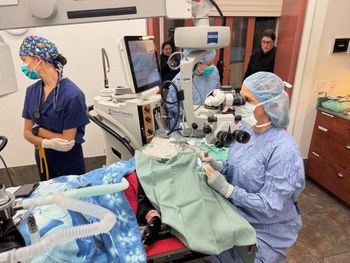
Ocular diseases of nontraditional and exotic pets (Proceedings)
When presented with exotic species with ocular disease it is important to remember the concept of "the same and different". Eye are eyes regardless of the species and many of the conditions we are presented with in pocket pets and other exotic species are in many ways the same as those we have come to recognize in the more usual domestic species and can be diagnosed and treated empirically in the same way.
When presented with exotic species with ocular disease it is important to remember the concept of "the same and different". Eye are eyes regardless of the species and many of the conditions we are presented with in pocket pets and other exotic species are in many ways the same as those we have come to recognize in the more usual domestic species and can be diagnosed and treated empirically in the same way.
However differences in anatomy, husbandry and nutritional requirements and susceptibility to unusual pathogens in the more exotic pet species do result in ocular diseases unique to exotics species which need more general awareness and knowledge of exotic or laboratory animal medicine than may be taught in conventional veterinary curricula.
The general concepts of a thorough and logical ophthalmic examination apply as much in exotics as domestic species although particular aspects of the anatomy or biology may affect how the examination is conducted. Many non-domestic and exotic species are likely to require an understanding of restrains and sedation techniques in order to effectively conduct the ophthalmic examination. Use of methods of examination from a distance and maximizing the use of photography can be very helpful in evaluation of ocular lesions.
Amphibians
Larval stages have eyes like teleost fish. Eyelids generally poorly developed in adult stages. Strong retractor bulbi muscles involved in eye protection and swallowing. Third eyelid may limit examination of the globe. Globe has cartilage present. Considerable variation in the appearance of the iris. Avascular retina with membrane vasculosa retinae (vitreal)
Ocular trauma is common (corneal ulcers). Cautious use of antibiotics due to skin absorption. Often difficult to medicate due to aquatic component of lifestyle. Panophthalmitis is seen bilaterally associated with systemic bacterial disease and stress 9often in overcrowded and recently shipped groups of animals).
Lipid keratopathy occurs commonly in captive species. White deposits in the corneal tissue with progression of keratitis with vascularization and pigmentation. This is diet related (often fed insects with high fat content. Reversal of the condition is not often effective and systemic involvement may be fatal.
Occasionally encounter cataracts and glaucoma of unknown etiology. Enucleation is possible for glaucoma.
Reptiles
Large lower eyelid which may have a clear window in some lizard species. Very strong lid closure in crocodilians and chelonians (also head retraction in shell) makes examination of the eye very difficult. This is compounded in species with a third eyelid which may obscure a view of the globe. Examination under anesthesia may allow for lid opening. Mydriasis requires non-depolarizing neuromuscular blocking drugs.
Lids in snakes and many gecko fused to form spectacle (which is a vascular structure) – this affects type of ocular diseases encountered (few obvious corneal ulcers, common to get infectious disease of the conjunctival space and problems associated with ecdysis). Lack of nasolacrimal duct in chelonians. Globe has sclera cartilage and in some species sclera ossicles. Considerable interspecies difference in the iris appearance and function. Variation in lens accommodative mechanisms. Fundus is avascular but lizards have a conus papillaris.
Ocular malformations are quite common – particularly in captive bred collections of animals. Causes are usually unknown.
Eyelid diseases may include viral, bacterial and fungal infections. These may reach epidemic proportions in both wild and captive animals. Predisposing cause are the stresses of shipping and poor environmental hygiene. Not infrequently bacterial and fungal ocular lesions may reflect other more insidious systemic infections. Surgical debridement and use of both systemic and topical anti-biotic and antifungal therapy is required.
Spectacle disorders are common in geckos and snakes. The spectacle is normally shed at each ecdysis. Spectacles may become indented and irregular in shape but usually self correct at the next shed. Retention of the spectacle during shedding can become a problem if the layers of spectacle accumulated. There is a predisposition in very dry environments and where ectoparasites are present. Increasing the humidity just before shedding and treatment of ectoparasites often is effective in resolving the problem. The retained spectacle should be removed manually with great care to avoid corneal exposure.
Infections in the space between the spectacle and cornea and conjunctiva are very common in geckos and snakes. These are often associated with systemic septicemia, necrotic stomatitis but may occasionally arise as congenital conditions associated with abnormal conjunctival sac drainage via the lacrimal duct to the mouth. Common bacterial isolates are typical of reptile infectious diseases (usually Gram –ve species). The significance of protozoa found in the exudates is unknown. Drainage and flushing of the exudates via a window in the spectacle may allow topical treatment – however recurrence is likely. In resolved cases scarring of the spectacle and cornea may result. Systemic antibacterial and antiprotozoal therapy is usually required.
Conjunctivitis is common is reptiles and diagnosis of the etiology is often difficult. Hypovitaminosis A may be associated with some of these cases. Many will however respond to empirical antibiotic, corticosteroid and NSAIDs therapy. Swelling of the eyelids and conjunctiva is commonly seen in chelonians due to hypovitaminosis A which reflects enlargement of the lacrimal glands due to squamous metaplasia. Systemic lesions of the viscera can be fatal if untreated. Correction of the diet to include vitamin A is usually curative.
Species without spectacles are commonly affected with traumatic corneal abrasions and ulcers.
Treatment is the same as in domestic mammals. Lipid keratopathy is seen commonly in older animals and does not warrant treatment.
Cataracts are common in reptiles – diet, environmental factors and age are the most likely causes. Uveitis occurs associated with systemic infectious disease. Glaucoma is a rare finding in reptiles.
Fish
Fish are relatively rarely diagnosed with ocular disease although many ocular conditions are recognized in this class. Fish lack eyelids, have a relatively thick cornea and the spherical lens comes very close to the corneal endothelium. Cartilage is present in the sclera. The teleost eye may have a falciform process or membrane vasculosa retina for retinal nutrition.
Numerous parasites, bacteria, viruses and fungi can affect the eyes of fish. Many of these may go un-noticed in the captive environment. Occasionally corneal lesions, uveitis, endophthalmitis, panophthalmitis or generalized dermatologic disease with ocular involvement may be noticed.
Corneal (opacification), lens (cataract), and intraocular lesions (hemorrhage, retinal degenerations) have been commonly reported associated with nutritional deficiencies or toxicities in fish.
Fish may develop gas bubble disease a metabolic condition when dissolved gases cause emboli and emphysema around the eye resulting in exophthalmos or intraocular lesions (hemorrhage, cataracts, and uveitis).
Birds
Birds have well developed eyelids and actively protruded third eyelid which can make ocular examination difficult. The shape of the avian eye falls into one of three patterns – this is of most significance when considering enucleation in raptor species. The avian skull has sinuses and air filled bones. Infra-orbital sinus infections often affect the eye. Scleral cartilage and sclera ossicles are present in many species. The cornea is quite thin even in larger species and can make corneal repair challenging. Skeletal muscle in the iris requires non-depolarizing neuromuscular blocking agents for mydriasis which is often ineffective. The fundus is avascular – a pecten arises over the optic nerve which shows considerable interspecies variation.
Developmental abnormalities are quite common and include eyelid agenesis, cataracts, microphthalmos and retinal dysplasia
Periocular sinusitis – swelling below and medial to the eye with infraorbital sinus involvement. Culture of aspirates – combined with sinus flushing and systemic antibiotic therapy based on culture and sensitivity results.
Blepharitis may be associated with viral (poxvirus), parasitic (Knemidocoptes), bacterial and occasionally fungal infections. Hypovitaminosis A is anecdotally associated with blepharoconjunctivitis. Trauma and inflammation of the lids may result in blepharophimosis/symblepharon. Surgical treatment is difficult and often results in recurrence. Neoplasia is occasionally seen in the eyelids and orbit in older animals.
Keratitis of various types has been reported in Amazon parrots and Mynah birds. Ulceration is diagnosed and treated in the same manner as other species. Tarsorraphy may be indicated to protect the cornea during healing. Non-healing ulcers can be treated with debridement and antibiotic therapy and cautious use of thermokeratoplasty.
Both cataracts and lens luxations occur in birds with some frequency. Both genetic and nutritional etiologies have been suggested. They have been seen in both caged birds and wild raptors presented to rehabilitation centers. Surgical removal of the lens is possible - phakoemulsification or lens aspiration has been used effectively.
Uveitis occurs due to infectious disease and trauma (especially raptors). Empirical therapy with NSAID and corticosteroids may be effective. Workup of any underlying systemic disease is indicated with appropriate therapy.
Retinal inflammation, detachment and degeneration is a common finding in raptors examined with blindness. Many of these cases are probably traumatic and limit efforts at rehabilitation.
Small Mammals (Pocket Pets)
Rodents, rabbits, guinea pigs, gerbils and hamsters are the species most commonly seen with eye lesions. Most of our knowledge of ocular disease in these species comes from laboratory animal medicine.
The eyes are obviously more similar to the other domestic species we ususually deal with and have many similar lesions. Anatomic variations include larger orbital vascular sinuses (which can make enucleation more difficult - but also have allowed for blood collection in laboratory animal studies.) Many rodents have large orbital glands and are prone to viral dacryoadenitis. The mouse, rat, hamster and gerbil retinas are holangiotic, guinea pigs are paurangiotic, rabbits are merangiotic, and chinchillas are anangiotic. Ferrets have eyes comparable to domestic carnivores.
Blepharitis may occur in rodents associated with dacryoadenitis virus conjunctivitis. Gerbils are prone to Periocular dermatitis – changing the bedding to sand may help. Prolapsed Harderian gland may be seen in gerbils.
Conjunctivitis with tear staining is associated with viral infection in rodents (sialodacryoadenitis virus) and occasionally bacterial infections. Topical antibiotics are indicated. The disease is often self-limiting but may become endemic in large colonies. Keratoconjunctivitis is seen in guinea pigs associated with Chlamydophila infection. Ferrets with distemper often present with conjunctivitis (high mortality). Rabbits are commonly affected with blepharoconjunctivitis and nasolacrimal duct obstruction associated with tooth root disease, and bacterial infections. Rabbits are prone to develop conjunctival overgrowth (conjunctiva covers the cornea) – etiology is uncertain but most likely inflammatory.
Corneal ulceration and lens opacification may occur in rodents associated with trauma or corneal exposure (during anesthesia) Opacification of the cornea is common in rats due to mineral depositing beneath the corneal epithelium – this appears to be an inherited tendency.
Uveitis and glaucoma are seen more commonly in rabbits than other species. (Rats and mice and hamsters may be seen with buphthalmos). Certain hamster species have a tendency to develop glaucoma. Underlying causes include sialodacryoadenitis virus, septicemia, bacterial infections (Pasteurella in rabbits) and parasitic disease (Encephalitozoon in rabbits). Glaucoma in rabbits may be secondary to uveitis or inherited. Treatment with carbonic anhydrase inhibitors and beta blockers may slow the progression of the disease but many end with enucleation. Guinea pigs with glaucoma may develop bone in the anterior chamber.
Cataracts are common in all small mammals and may be genetic or associated with nutritional problems or uveitis or old age. Surgical removal is rarely indicated except in rabbits.
Intraocular hemorrhage is common in rats and occasionally mice. Inherited retinal degenerations are common in these species.
Exophthalmos is a common finding in ferrets with lymphosarcoma.
Other Mammals.
Many of the diseases we see in other mammalians species (either as pets or in zoological collections) mimic the conditions we encounter in domestic species. Diagnosis and treatment is similar in all cases. A few examples will be presented.
Newsletter
From exam room tips to practice management insights, get trusted veterinary news delivered straight to your inbox—subscribe to dvm360.





